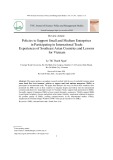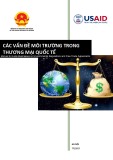
Journal of Information Systems Engineering and Management
2025, 10(46s)
e-ISSN: 2468-4376
https://www.jisem-journal.com/
Research Article
907
Copyright © 2024 by Author/s and Licensed by JISEM. This is an open access article distributed under the Creative Commons Attribution License
which permits unrestricted use, distribution, and reproduction in any medium, provided the original work is properly cited.
Impact of the US-China Trade War on Vietnam's Import and
Export
Doan Ba Toai
Faculty of Foreign Languages, Thanh Dong University, Hai Duong, Vietnam
Email: doanbatoai@thanhdong.edu.vn
ARTICLE INFO
ABSTRACT
Received: 28 Dec 2024
Revised: 18 Feb 2025
Accepted: 26 Feb 2025
The US-China trade war, initiated in 2018, has significantly reshaped global trade flows,
influencing the economic trajectories of several countries, including Vietnam. This paper
explores the impact of the trade tensions between the world’s two largest economies on
Vietnam’s import and export structure. Using secondary data and recent literature, we examine
the trade war's implications for Vietnam's export growth to the United States, shifts in its
import patterns particularly from China and broader changes in global value chains. The study
finds that Vietnam has benefited from trade diversion effects, enhancing its position as a
manufacturing and export hub. However, it also faces challenges such as increasing
dependence on imported inputs, risks of protectionist measures, and heightened competition
from regional peers. The paper concludes with policy recommendations for Vietnam to sustain
its trade performance amid ongoing geopolitical tensions.
Keywords: Import and export trade, Comparison between China and the United States, trade
war, Vietnam's import and export.
1. INTRODUCTION
The US-China trade war, which formally commenced in 2018 with the imposition of sweeping tariffs by the United
States under Section 301 of the Trade Act of 1974, represents a pivotal moment in the evolution of global economic
relations. This conflict, sparked by U.S. accusations of intellectual property theft, forced technology transfers, and
trade imbalances, led to the imposition of tariffs on over $360 billion in Chinese goods and prompted symmetrical
retaliatory measures from China (Bown, 2020; Ciuriak, 2019). The escalation of protectionist policies severely
disrupted established global supply chains and injected uncertainty into cross-border investment and trade flows
(Evenett & Fritz, 2019).
Amidst this geopolitical upheaval, multinational corporations began reevaluating the concentration of their
manufacturing bases in China, seeking to mitigate risk by relocating production to alternative destinations in Asia.
Vietnam, due to its strategic geographic location, favorable trade agreements, competitive labor costs, and pre-
existing integration into regional production networks, emerged as a viable substitute in the “China Plus One”
strategy adopted by many global firms (Anwar & Nguyen, 2021). This shift not only provided Vietnam with
opportunities to expand its export markets particularly the United States but also intensified its role in global value
chains (GVCs), especially in labor-intensive manufacturing sectors such as electronics, textiles, and furniture
(World Bank, 2020).
However, Vietnam’s growing prominence as a trade alternative to China comes with complex trade-offs. While the
country has witnessed substantial export growth, it remains heavily reliant on intermediate goods from China,
raising concerns about supply chain vulnerability and trade dependency (Nguyen & Tran, 2022). Moreover, the
trade surplus with the United States has led to increased scrutiny and potential exposure to protectionist measures
from Washington, including anti-dumping investigations and currency manipulation claims (U.S. Department of
Commerce, 2020).
This paper explores how the US-China trade war has reshaped Vietnam’s trade structure, focusing on both
opportunities and risks. Specifically, it investigates the surge in Vietnam’s exports to the United States, the shifting
patterns of its imports particularly the overreliance on Chinese inputs and the strategic responses required to

Journal of Information Systems Engineering and Management
2025, 10(46s)
e-ISSN: 2468-4376
https://www.jisem-journal.com/
Research Article
908
Copyright © 2024 by Author/s and Licensed by JISEM. This is an open access article distributed under the Creative Commons Attribution License
which permits unrestricted use, distribution, and reproduction in any medium, provided the original work is properly cited.
ensure sustainable trade growth in a geopolitically uncertain world.
2. LITERATURE REVIEW
The analysis of the US-China trade war's impact on Vietnam’s trade structure can be anchored in several key
international trade theories and economic concepts. These theoretical lenses provide the foundation for
understanding Vietnam’s evolving role within global value chains (GVCs), the dynamics of trade diversion, and the
implications of geopolitical shocks on small open economies.
2.1 Comparative Advantage and Trade Diversion
At the core of classical trade theory is David Ricardo’s (1817) principle of comparative advantage, which posits that
countries should specialize in producing goods for which they have a relative efficiency advantage. Vietnam, with its
abundance of low-cost labor and improving manufacturing capacity, has increasingly specialized in labor-intensive
sectors such as electronics assembly, garments, and furniture. As a result, when the United States imposed tariffs
on Chinese goods, Vietnam was well-positioned to offer alternative sources of similar products, leading to a trade
diversion effect (Bown & Zhang, 2019).
Trade diversion refers to the shifting of trade flows from a more efficient supplier (e.g., China) to a less efficient but
tariff-free alternative (e.g., Vietnam), due to changes in trade policy (Viner, 1950). In this context, Vietnam’s surge
in exports to the United States is not merely a reflection of increased competitiveness but also of artificially induced
demand caused by tariff distortions. This reinforces the notion that geopolitical tensions can temporarily alter trade
patterns, sometimes independent of true production efficiency.
2.2 Global Value Chains and Vertical Specialization
Modern trade is increasingly characterized by vertical specialization within global value chains (GVCs), where
production processes are fragmented across countries (Hummels, Ishii, & Yi, 2001). Vietnam’s integration into
GVCs, particularly in electronics and intermediate goods, means that its export performance is deeply tied to its
import of inputs especially from China. Thus, even as Vietnam benefits from increased final goods exports, its
economic success remains tightly interwoven with upstream suppliers, making it vulnerable to input disruptions or
price shocks (Gereffi & Fernandez-Stark, 2016).
This dependency aligns with network trade theory, which suggests that countries located downstream in the
production process face constraints in moving up the value chain unless they develop domestic supplier networks
and technological capabilities (Baldwin, 2012). Therefore, Vietnam’s export boom fueled by the trade war
simultaneously reveals structural weaknesses in its industrial ecosystem.
2.3 Strategic Trade Theory and Government Intervention
Strategic trade theory, which emerged in the 1980s, challenges the assumption of perfect competition and supports
the idea that governments can intervene in trade to support domestic industries in gaining competitive advantage
in global markets (Krugman, 1986). Vietnam’s proactive signing of trade agreements such as the Comprehensive
and Progressive Agreement for Trans-Pacific Partnership (CPTPP) and the Regional Comprehensive Economic
Partnership (RCEP) reflects a form of statecraft aimed at securing export markets and minimizing exposure to
great-power rivalries.
Moreover, Vietnam’s industrial policy characterized by tax incentives for foreign manufacturers, special economic
zones, and infrastructure investment demonstrates its strategic intent to position itself as a key node in supply
chain realignments driven by the trade war (World Bank, 2020). These policy maneuvers underscore the role of the
state in responding to external trade shocks with internal resilience strategies.
2.4 Small Open Economy Vulnerabilities
From a macroeconomic perspective, Vietnam exemplifies the characteristics of a small open economy, highly
susceptible to external shocks (Obstfeld & Rogoff, 1995). The trade war illustrates how shifts in external demand
and global trade policy can rapidly reconfigure Vietnam’s economic landscape. The sudden inflow of foreign direct
investment (FDI) and export demand may lead to overdependence on a single market, increased trade imbalances,

Journal of Information Systems Engineering and Management
2025, 10(46s)
e-ISSN: 2468-4376
https://www.jisem-journal.com/
Research Article
909
Copyright © 2024 by Author/s and Licensed by JISEM. This is an open access article distributed under the Creative Commons Attribution License
which permits unrestricted use, distribution, and reproduction in any medium, provided the original work is properly cited.
or even retaliatory scrutiny, as evidenced by U.S. concerns over currency manipulation and trade circumvention.
Thus, while Vietnam appears to be a beneficiary in the short term, long-term sustainability depends on its ability to
diversify markets, deepen domestic industrial capabilities, and navigate the complex terrain of great-power rivalry.
3. METHODOLOGY
This study employs a qualitative-descriptive methodology anchored in empirical trade data and policy analysis to
examine how the US–China trade war has reshaped Vietnam’s import and export patterns. The rationale for
choosing a qualitative-descriptive approach lies in the complex and multifaceted nature of the trade war’s effects,
which require contextual interpretation rather than solely statistical inference. The aim is not merely to quantify
trade flows but to interpret structural shifts, policy responses, and strategic behavior within the broader framework
of international political economy. This approach is consistent with previous studies that examine the spillover
effects of trade conflicts on third-party economies (Bown & Zhang, 2019; Anwar & Nguyen, 2021).
The analysis is based on secondary data sources, including macroeconomic statistics and policy documents
published by international organizations and national authorities. Key data sources include the UN Comtrade
Database, which provides standardized bilateral trade data between Vietnam, the United States, and China across
product categories (HS codes), allowing for the identification of trade diversion effects. Additionally, national data
from the General Statistics Office of Vietnam (GSO) offers insight into sector-specific trade performance and FDI
inflows. Complementary information was drawn from institutional reports published by the World Trade
Organization (WTO), International Monetary Fund (IMF), and the World Bank, which help contextualize Vietnam’s
trade trends within global economic developments. Peer-reviewed journal articles and official policy
communications were also reviewed to incorporate theoretical and institutional perspectives.
To analyze these data, the study applies a combination of descriptive statistical techniques and comparative trade
flow analysis. Descriptive statistics were used to track changes in Vietnam’s exports to the United States and
imports from China between 2015 and 2023. This period captures the pre-trade war baseline, the escalation phase
(2018–2020), and the post-tariff adjustment era. Comparative analysis was then employed to juxtapose Vietnam’s
trade performance with that of China, highlighting areas where Vietnam gained market share in response to U.S.
tariffs on Chinese goods. Additionally, an Import Source Concentration Index (SCI) was computed to evaluate
Vietnam’s level of dependency on Chinese intermediate goods, shedding light on upstream vulnerabilities in its
supply chains.
Beyond numerical analysis, the study incorporates policy content analysis to assess Vietnam’s strategic responses to
the shifting global trade environment. Government policies related to investment incentives, export promotion,
trade agreement utilization (such as CPTPP and RCEP), and industrial development were examined to understand
how Vietnam is positioning itself in the post-trade war order. This aspect of the methodology reflects the influence
of strategic trade theory, acknowledging the proactive role of state interventions in shaping trade outcomes under
conditions of geopolitical uncertainty (Krugman, 1986).
While the study provides a robust account of macro-level trade shifts, several limitations must be acknowledged.
First, the reliance on secondary data precludes a firm-level microanalysis that could capture intra-industry
relocation behavior, such as supply chain decisions by multinational corporations. Second, inconsistencies in data
classification and reporting across sources particularly in terms of HS code disaggregation and valuation methods
may introduce minor discrepancies in trade flow estimation. Third, the overlap of the US-China trade war with the
COVID-19 pandemic complicates causal attribution, as both events likely influenced trade performance in
overlapping periods. Despite these limitations, the methodological triangulation of statistical data, institutional
reports, and policy narratives ensures a comprehensive and credible analysis.
In summary, the study’s methodological framework rooted in qualitative description and supported by empirical
trade data enables a nuanced understanding of how a global trade conflict has restructured Vietnam’s external
economic relations. The approach emphasizes not only the measurable outcomes of trade diversion but also the
strategic responses and structural vulnerabilities that will shape Vietnam’s future role in international commerce.

Journal of Information Systems Engineering and Management
2025, 10(46s)
e-ISSN: 2468-4376
https://www.jisem-journal.com/
Research Article
910
Copyright © 2024 by Author/s and Licensed by JISEM. This is an open access article distributed under the Creative Commons Attribution License
which permits unrestricted use, distribution, and reproduction in any medium, provided the original work is properly cited.
4. RESEARCH RESULTS
4.1. Surge in Exports to the United States
Between 2020 and 2024, Vietnam's exports to the United States experienced a significant increase, rising from
approximately $83 billion in 2020 to over $119.5 billion in 2024. This growth was driven by the relocation of
manufacturing operations from China to Vietnam, as companies sought to avoid U.S. tariffs on Chinese goods. Key
export sectors included electronics, textiles, furniture, and machinery. By 2024, the United States accounted for
29.5% of Vietnam's total export turnover, solidifying its position as Vietnam's largest export market.
Fig 1. Vietnam's Trade with US and China 2020-2024
(Sources: General Department of Vietnam Customs, 2024)
The line chart above illustrates the trend in Vietnam’s exports to the United States and imports from China between
2020 and 2024, measured in billion USD. This comparative visualization offers rich insight into the asymmetric but
interdependent nature of Vietnam’s external trade relations with two of the most geopolitically consequential
economies of the 21st century.
From the chart, both lines show a consistently upward trajectory, signifying that Vietnam's exports to the US and
imports from China have grown significantly during this five-year period:
Exports to the U.S. increased from $83.0 billion in 2020 to $119.5 billion in 2024, indicating a compound annual
growth rate (CAGR) of approximately 9.4%. Imports from China rose from $83.6 billion to $118.7 billion, reflecting
a similar CAGR of 9.1%. At first glance, this parallel growth may seem like a balanced expansion of trade; however,
deeper analysis reveals a more complex, possibly structurally dependent relationship.
The divergence post-2021, where exports to the US begin to surpass imports from China—can be attributed to the
trade diversion effect stemming from the US–China trade war. As U.S. tariffs made Chinese products less
competitive, many multinational firms shifted production to Vietnam. This shift is vividly captured by the sharp
increase in exports from 2021 to 2022, where the export line overtakes the import line.
This inflection point may symbolize Vietnam’s emergence as a substitute manufacturing hub in global value chains,
particularly in electronics, textiles, and furniture. The ability to "absorb" this diverted trade underlines Vietnam's
improving industrial capabilities and business climate but also flags exposure to external trade conflicts.
Despite export gains, imports from China continue to grow at nearly the same pace, suggesting that Vietnam’s
export strength is heavily input-dependent. The nature of imports mainly intermediate goods, raw materials, and
electronics components points to vertical specialization, where Vietnam serves as a downstream assembler in East
Asian production networks.

Journal of Information Systems Engineering and Management
2025, 10(46s)
e-ISSN: 2468-4376
https://www.jisem-journal.com/
Research Article
911
Copyright © 2024 by Author/s and Licensed by JISEM. This is an open access article distributed under the Creative Commons Attribution License
which permits unrestricted use, distribution, and reproduction in any medium, provided the original work is properly cited.
This is a red flag in terms of supply chain sovereignty. Any disruption in trade relations with China (due to
diplomatic tensions, shipping crises, or global pandemics) could undermine Vietnam’s production capability and
export commitments, particularly to the U.S. and EU markets.
4.2. Rising Dependence on Chinese Imports
From 2020 to 2024, Vietnam's imports from China increased from $83.6 billion to $118.7 billion, marking a 42%
growth over five years. This consistent upward trend is not a generic increase in consumer goods; rather, it is
structurally embedded in Vietnam’s production-based export economy.
Fig 2. Vietnam’s Import Composition From China (2024, Estimated)
(Sources: General Department of Vietnam Customs, 2024)
The pie chart titled "Vietnam’s Import Composition from China (2024, Estimated)" reveals the predominance of
intermediate goods: Semiconductors & Electronics (33%): Essential for the assembly of mobile phones, televisions,
and computing devices sectors where Vietnam has become a global assembly hub. Textile Fabrics (22%): Serve
Vietnam’s garment and footwear industries, whose exports are heavily reliant on imported fabric and dyes.
Industrial Machinery (18%) and Chemical Inputs (15%): Required for operating export-oriented factories, including
food processing and plastic manufacturing. Other Inputs (12%): Include plastic pellets, steel components, and
specialized tools.
4.3. Trade Surplus with the USA
Vietnam’s trade surplus with the United States nearly doubled, from $63.2 billion in 2020 to $123.4 billion in 2024.
While this presents a short-term economic win, it has raised strategic alarms in U.S. policy circles. The U.S.
Treasury in late 2024 reiterated concerns about Vietnam’s trade practices and exchange rate policy, prompting
fears of anti-dumping duties or punitive tariffs.
Fig 3. Vietnam's Trade with the US (2020-2024): Exports vs Imports
(Sources: General Department of Vietnam Customs, 2024)










![Thương mại quốc tế: Tổng quan [Phần 1]](https://cdn.tailieu.vn/images/document/thumbnail/2016/20160105/tuanhung_vn/135x160/470404998.jpg)



![Đề thi cuối kì Chính sách thương mại quốc tế: Tổng hợp [năm]](https://cdn.tailieu.vn/images/document/thumbnail/2025/20251112/llinhlinhlinhlinhh@gmail.com/135x160/60241762917589.jpg)






![Đề thi Luật Thương mại quốc tế học kì 1 năm 2024-2025 có đáp án (Đề 1) - [kèm đề thi]](https://cdn.tailieu.vn/images/document/thumbnail/2025/20250925/kimphuong1001/135x160/14521758785752.jpg)




